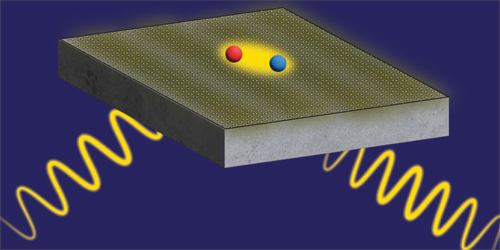Strong Light–Matter Coupling in the Simplest Geometry
Structures that exhibit strong light–matter coupling can change their optical properties under illumination, offering many potential applications in nanophotonics and optoelectronics. Among the most promising materials for creating these structures are single-layer transition-metal dichalcogenides (TMDs) on top of a silver film. Conventionally, this heterostructure is encased within a microcavity, which enhances the coupling strength at the cost of increasing its fabrication complexity. The microcavity can also limit access to the TMD for postfabrication manipulation. Now Nicolas Zorn Morales at Humboldt University of Berlin and colleagues have shown that strong light–matter coupling can be achieved even without such a microcavity [1]. Their experiments confirm theoretical predictions by other researchers.
The researchers fabricated their structure using single-layer tungsten disulfide grown by physical vapor deposition. Most experiments on TMDs have used flakes exfoliated from bulk crystals, which are typically smaller than 100 µm2. The vapor-deposition method, in contrast, yields centimeter-scale samples. The team preserved the high quality of this large-area monolayer while transferring it to the silver film, which enabled the use of total internal reflection ellipsometry (TIRE) to test the light–matter coupling. TIRE, usually used for biosensing applications, involves shining light onto the sample and measuring the amplitude and phase changes upon reflection. The phase change distinguishes directly between the strong and weak coupling regimes, whereas techniques used in previous studies can yield ambiguous results.
The team measured the induced “mixing” between the light and matter energy levels in their samples to be 26 meV (higher values indicate stronger light–matter coupling). This coupling strength is about half of that reported for devices using microcavities yet is still in the strong-coupling regime. The researchers say that their highly tunable and simple devices provide a new platform for designing plasmonic modulators, switches, and sensors.
Correction (14 November 2023): A sentence was added to the end of the first paragraph to clarify that the experimental phenomenon observed by Nicolas Zorn Morales and his team was previously predicted by another group.
–Martin Rodriguez-Vega
Martin Rodriguez-Vega is an Associate Editor for Physical Review Letters.
References
- N. Zorn Morales et al., “Strong coupling of monolayer WS2 excitons and surface plasmon polaritons in a planar Ag/WS2 hybrid structure,” Phys. Rev. B 108, 165426 (2023).




